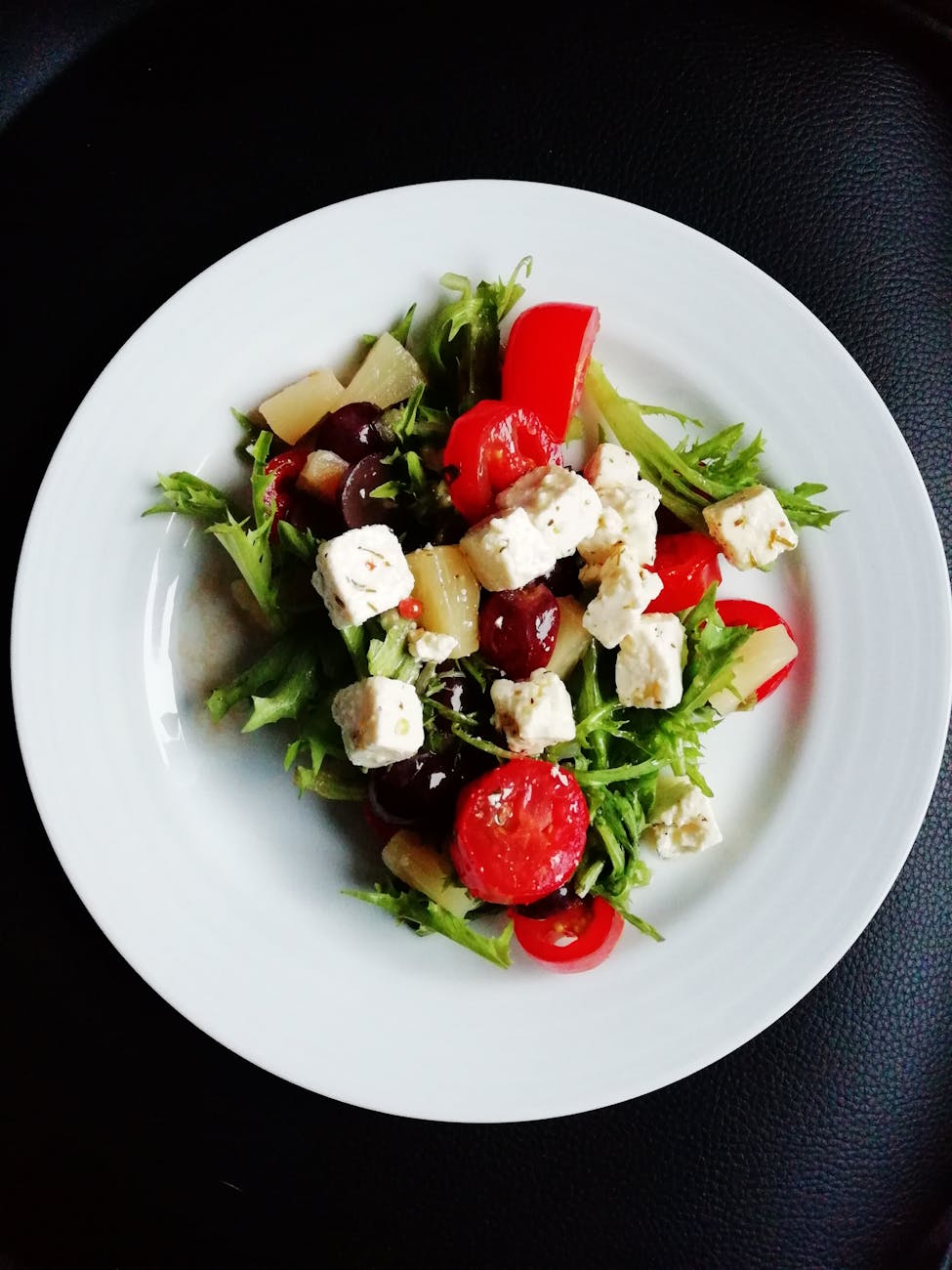Low Cholesterol Meals Introduction
Need advice on low cholesterol meals? Ever felt the weight of your health choices? Managing cholesterol levels can seem daunting, especially when you love your food. But what if I told you that you could enjoy delicious meals without compromising heart health? Welcome to our guide on low-cholesterol meals that keep your heart happy and your taste buds thrilled!
Managing cholesterol is crucial for preventing heart attacks, strokes, and other cardiovascular diseases as you enter your 40s and 50s. This post explores what cholesterol is, the benefits of a low-cholesterol diet, and provides practical, tasty meal ideas. Let’s dig in!
What is Cholesterol?
Cholesterol: The Good and the Bad
Cholesterol is a waxy substance found in your blood. It’s essential for building healthy cells, but too much can lead to heart disease. There are two main types of cholesterol:
- Low-Density Lipoprotein (LDL): Often referred to as “bad” cholesterol, high levels of LDL can lead to plaque buildup in your arteries.
- High-Density Lipoprotein (HDL): Known as “good” cholesterol, HDL helps remove other forms of cholesterol from your bloodstream.
Maintaining a balance between LDL and HDL is key to keeping your heart healthy. But how do you do that? Let’s explore.
Cholesterol: Effects on the Body
High LDL levels can narrow or block arteries, increasing your risk of heart attacks and strokes. On the other hand, HDL helps clear cholesterol from your blood, protecting against these conditions. Understanding how these work can guide your dietary choices for better heart health.
Cholesterol: Why It Matters
With heart disease being a leading cause of death globally, managing cholesterol levels should be a priority. The good news is, making small, simple changes to your diet can make a big difference.
Understanding Low Cholesterol Diets
Low Cholesterol Foods to Eat
Adopting a low-cholesterol diet involves incorporating foods that help lower LDL levels while supporting HDL. Some excellent choices include:
- Oats and Barley: Rich in beta-glucan, which helps reduce LDL.
- Nuts: Almonds, walnuts, and other nuts are great for boosting HDL.
- Fruits and Vegetables: Packed with fiber and antioxidants.
High Cholesterol: Foods to Avoid
Equally important is knowing what to avoid. Steer clear of:
- Trans Fats: Found in fried foods and baked goods.
- Saturated Fats: Present in red meat and full-fat dairy products.
- Processed Foods: Often high in unhealthy fats and sugars.
Cholesterol: Role of Fiber and Healthy Fats
Dietary fiber, particularly soluble fiber, can reduce the absorption of cholesterol into your bloodstream. Healthy fats, like those found in olive oil and avocados, help improve your cholesterol profile. Plant-based foods are generally lower in cholesterol and rich in nutrients that support heart health.
Meal Ideas for a Low Cholesterol Diet
Breakfast
Kickstart your day with heart-healthy options:
- Oatmeal with Berries: Top your oats with blueberries and a sprinkle of flaxseeds.
- Avocado Toast: Use whole grain bread and add a dash of lemon juice.
- Smoothie Bowl: Blend spinach, banana, and almond milk, then top with chia seeds and berries.
Lunch
These midday meals are both nutritious and satisfying:
- Quinoa Salad: Mix quinoa with chickpeas, cucumber, tomatoes, and a light vinaigrette.
- Turkey Wrap: Use a whole wheat tortilla, lean turkey breast, and lots of veggies.
- Lentil Soup: Hearty and filling, packed with fiber and protein.
Dinner
End your day with these delicious options:
- Grilled Salmon: Serve with steamed broccoli and brown rice.
- Stuffed Bell Peppers: Fill with a mixture of black beans, corn, and quinoa.
- Stir-Fried Tofu and Vegetables: Use a variety of colorful veggies and a splash of soy sauce.
Snacks
Healthy snacking can help maintain energy levels and curb cravings:
- Apple Slices with Almond Butter: A perfect blend of fiber and healthy fats.
- Hummus and Carrot Sticks: Crunchy and satisfying.
- Mixed Nuts: A handful can go a long way in boosting HDL.
The Importance of Portion Control and Cooking Methods
Mind Your Portions
Even healthy foods can contribute to high cholesterol if eaten in large quantities. Keep portion sizes reasonable to maintain a balanced diet. For instance, a serving of nuts is a small handful, not a whole bag.
Healthy Cooking Techniques
How you cook your food is just as important as what you eat. Opt for:
- Grilling: Reduces the need for added fats.
- Steaming: Preserves nutrients without adding calories.
- Baking: A healthier alternative to frying.
Avoid Unhealthy Additions
Be cautious of sauces and dressings that can add unwanted fats and sugars to your meals. Choose olive oil, lemon juice, or vinegar instead.
Lifestyle Tips for Managing Cholesterol
Regular Exercise
Physical activity is crucial for maintaining healthy cholesterol levels. Aim for at least 30 minutes of moderate exercise most days of the week. Walking, cycling, and swimming are excellent options.
Stress Management
Chronic stress can negatively impact your cholesterol levels. Incorporate stress-reducing activities like yoga, meditation, or deep breathing exercises into your routine.
Avoid Smoking and Limit Alcohol
Smoking lowers good HDL cholesterol and raises bad LDL cholesterol. Quitting smoking can improve your HDL cholesterol level. Similarly, limiting alcohol intake can help manage your cholesterol levels.
Managing Cholesterol Conclusion
Managing cholesterol levels doesn’t mean giving up on delicious meals. By understanding what cholesterol is, adopting a low-cholesterol diet, and incorporating healthy lifestyle habits, you can significantly improve your heart health. Remember, small changes can lead to significant results.
Ready to take the next step? Start by incorporating these meal ideas into your daily routine. For personalized advice, consider consulting with a nutritionist or dietitian. Your heart will thank you for it!

Delightful Low Cholesterol Recipes for Non-Cooks
Leading a heart-healthy lifestyle doesn’t mean you have to spend hours in the kitchen. If you’re a busy professional or someone who prefers to keep cooking simple, you’re in the right place. In this blog post, we will explore seven easy-to-make, low-cholesterol recipes that are not only nutritious but also delicious. By the end, you’ll discover that eating well can be both effortless and enjoyable.
Low Cholesterol Recipes for Non-Cooks Breakfast Ideas
Overnight Oats with Berries
A no-cook breakfast that’s ready when you wake up.
- Ingredients:
- 1 cup rolled oats
- 1 cup almond milk
- 1/2 cup mixed berries
- 1 tbsp chia seeds
- Instructions:
- Combine all ingredients in a jar.
- Refrigerate overnight.
- Enjoy in the morning!
Smoothie Bowl
Quick, nutritious, and customizable.
- Ingredients:
- 1 banana
- 1/2 cup spinach
- 1/2 cup almond milk
- 1 tbsp flaxseeds
- Instructions:
- Blend all ingredients until smooth.
- Pour into a bowl and add your favorite toppings like granola or fresh fruit.
Low Cholesterol Recipes for Non-Cooks Lunch Options
Quinoa and Black Bean Salad
A protein-packed meal that requires minimal prep.
- Ingredients:
- 1 cup cooked quinoa
- 1 cup black beans
- 1/2 cup corn
- 1/4 cup cilantro
- Juice of 1 lime
- Instructions:
- Mix all ingredients in a bowl.
- Serve chilled.
Hummus and Veggie Wrap
Simple, filling, and heart-healthy.
- Ingredients:
- 1 whole wheat tortilla
- 1/2 cup hummus
- 1/2 cup sliced cucumber
- 1/2 cup shredded carrots
- Instructions:
- Spread hummus on the tortilla.
- Add cucumber and carrots.
- Roll up and enjoy.
Low Cholesterol Recipes for Non-Cooks Dinner Delights
Baked Salmon with Asparagus
Effortless and packed with omega-3 fatty acids.
- Ingredients:
- 2 salmon fillets
- 1 bunch asparagus
- 1 tbsp olive oil
- Salt and pepper to taste
- Instructions:
- Preheat oven to 375°F.
- Place salmon and asparagus on a baking sheet.
- Drizzle with olive oil and season with salt and pepper.
- Bake for 20 minutes.
Chickpea Stir-Fry
A quick, one-pan dinner that’s full of flavor.
- Ingredients:
- 1 can chickpeas, drained
- 1 bell pepper, sliced
- 1 cup broccoli florets
- 2 tbsp soy sauce
- Instructions:
- Heat a pan over medium heat.
- Add all ingredients and stir-fry for 10 minutes.
Low Cholesterol Recipes for Non-Cooks Snack Suggestions
Apple Slices with Almond Butter
A sweet and satisfying snack.
- Ingredients:
- 1 apple, sliced
- 2 tbsp almond butter
- Instructions:
- Spread almond butter on apple slices.
Greek Yogurt with Honey and Walnuts
Rich in protein and healthy fats.
- Ingredients:
- 1 cup Greek yogurt
- 1 tbsp honey
- 1/4 cup walnuts
- Instructions:
- Mix honey and walnuts into yogurt.
Portion Control and Cooking Methods
Being mindful of portion sizes and cooking methods can significantly impact the cholesterol content of your meals. Here are some tips to help you:
- Portion Control – Use smaller plates and bowls to help manage portion sizes.
- Grilling and Baking – These methods are healthier alternatives to frying.
- Steaming – Retains more nutrients in vegetables compared to boiling.
Lifestyle Tips for Managing Cholesterol
- Exercise Regularly
Physical activity can help raise HDL cholesterol and lower LDL cholesterol. Aim for at least 30 minutes of moderate exercise most days of the week.
- Stay Hydrated
Drinking plenty of water can help flush out toxins and improve overall health. Aim for at least eight glasses a day.
- Stress Management
Chronic stress can negatively impact your cholesterol levels. Practice stress-reducing activities like yoga, meditation, or deep breathing exercises.
- Low-Cholesterol Recipes for Non-Cooks Conclusion
Managing your cholesterol levels doesn’t have to be a daunting task, even if you don’t like to cook. By incorporating these seven simple, low-cholesterol recipes into your diet, you can enjoy delicious meals while taking care of your heart. Remember, small changes can lead to big improvements in your health.
If you’re looking for more personalized advice, consider booking a consultation with a nutrition expert who can help you tailor a plan that fits your lifestyle. And always remember, a healthy heart is a happy heart!

Narcissists Can Mess With Your Heart in More Than One Way: High Cholesterol
Have you ever wondered if your high cholesterol levels could be connected to the stress of dating a narcissist? If you’re a health-conscious individual, nutrition enthusiast, or someone keen on avoiding strokes and heart attacks, this blog post is for you. Even busy professionals can benefit from the insights shared here. We’ll explore how the stress from a toxic relationship can impact your cholesterol and overall well-being. By the end of this read, you’ll have practical tips to manage both your emotional and physical health.
Understanding Cholesterol
- Impact on the Body
High cholesterol levels can be detrimental to your health. LDL can clog arteries, leading to reduced blood flow and increased risk of cardiovascular diseases. On the flip side, higher levels of HDL are beneficial as they help clear bad cholesterol from your system.
- The Stress Connection
Stress plays a significant role in affecting your cholesterol levels. When you’re stressed, your body releases cortisol, a hormone that can increase blood fat levels, including LDL cholesterol. Chronic stress can also lead to unhealthy behaviors like poor eating habits, smoking, and excessive drinking, all of which can further spike your cholesterol levels.
Relationship with a Narcissist The Stress Factor
- Behaviors of a Narcissistic Partner
Being in a relationship with a narcissist can be incredibly stressful. Narcissists tend to be manipulative, lack empathy, and create a toxic environment. Their behavior can make you feel constantly on edge, leading to chronic stress.
- Physiological Effects of Stress
The physiological effects of stress are vast. Chronic stress can increase your heart rate and blood pressure, leading to higher levels of LDL cholesterol. Stress also triggers the release of triglycerides into the bloodstream, another type of fat that can contribute to heart disease.
- Real-Life Impact
Imagine coming home after a long day at work, only to face constant criticism and emotional manipulation. This ongoing stress can make you turn to comfort foods or other unhealthy habits, further exacerbating your cholesterol levels and overall health.
Nutrition for Stress Management and Lowering Cholesterol
- Dietary Tips
One of the most effective ways to manage stress and lower cholesterol is through proper nutrition. Incorporate foods rich in omega-3 fatty acids, such as salmon and flaxseeds, which can help reduce inflammation and lower LDL levels. Also, add plenty of fruits and vegetables to your diet, as they are high in fiber and antioxidants.
- Importance of Self-Care
Self-care is crucial when dealing with both stress and high cholesterol. Engage in activities that help you relax and unwind, such as yoga, meditation, or even a simple walk in the park. These activities can help lower cortisol levels and improve your overall well-being.
- Emotional Support
Don’t underestimate the power of emotional support. Talking to friends, joining support groups, or seeking therapy can provide you with the emotional backing you need to manage stress effectively. This emotional stability can have a positive impact on your physical health as well.
Real Stories and Experiences
- Personal Accounts
Many people have faced high cholesterol levels due to the stress of being in a toxic relationship. Take Jane, for example. She found herself binge-eating junk food and drinking excessively to cope with the stress from her narcissistic partner. Over time, her cholesterol levels skyrocketed, putting her at risk for heart disease.
- Unhealthy Coping Mechanisms
Like Jane, many find solace in unhealthy coping mechanisms. Increased drinking, smoking, and eating processed foods can provide temporary relief but have long-term negative effects on your health. Just as a toxic partner is unhealthy for you, so are these lifestyle choices.
- Breaking the Cycle
The first step to breaking this cycle is recognizing it. Once you understand the connection between your stress, behaviors, and health, you can take proactive steps to improve your situation. Seek professional help and focus on adopting healthier habits.
Seeking Professional Help for Managing Stress and Cholesterol
- Guidance on Managing Stress
If you find it challenging to manage stress on your own, seeking professional help is a wise decision. Therapists and counselors can provide you with strategies to cope with the emotional toll of a toxic relationship.
- Managing Cholesterol
A healthcare provider can offer personalized advice for managing your cholesterol levels. This may include medication, dietary changes, or both. Regular check-ups can help monitor your progress and make necessary adjustments.
- Addressing Toxic Relationships
Sometimes, the best course of action is to remove yourself from the toxic environment. Professional guidance can help you make this transition smoothly, ensuring you have the emotional and practical support you need.
In summary, the stress from dating a narcissist can significantly impact your cholesterol levels and overall health. Understanding the connection between stress and cholesterol, along with adopting healthy dietary and lifestyle changes, can make a significant difference. Prioritize your well-being and don’t hesitate to seek professional help if needed.
Your health is your wealth. Take action today to improve both your emotional and physical well-being. Share your experiences or seek further advice to continue your journey toward a healthier, happier life.

A Healthy Romance with Food Navigating Low Cholesterol Choices in Greek, Italian, and Japanese Menus
In today’s fast-paced world, maintaining a healthy diet is essential, especially for those who are conscious of their cholesterol levels. Balancing personal relationships, work, and health can be challenging, but making informed dietary choices can significantly impact your overall well-being. This blog post will explore how to make low cholesterol choices in Greek, Italian, and Japanese menus, even when dealing with the stress of an unhealthy relationship.
The Narcissist Diet Connection
Relationships can profoundly affect our eating habits. If you’re dating a narcissist, the constant stress and emotional turmoil can lead to poor dietary choices, including indulging in high-cholesterol comfort foods. Stress triggers the release of cortisol, a hormone that increases appetite and cravings for unhealthy foods. Consequently, managing cholesterol levels becomes even more crucial.
It’s essential to recognize the impact of an unhealthy relationship on your diet. Maintaining self-awareness and prioritizing your health can help mitigate these effects. By making conscious food choices, you can counteract the negative influences and support your overall well-being.
Low Cholesterol Greek Cuisine Healthy Choices
Greek cuisine offers numerous delicious, low-cholesterol options that are both satisfying and nutritious. Here are some healthy choices to consider when dining at a Greek restaurant:
- Grilled Fish and Seafood
Greek dishes often feature grilled fish and seafood, such as salmon, shrimp, and octopus. These options are rich in omega-3 fatty acids, which can help lower bad cholesterol levels and support heart health. Opt for grilled or broiled preparations instead of fried to keep your meal light and healthy.
- Greek Salads and Vegetables
A classic Greek salad, known as horiatiki, is a fantastic low-cholesterol option. It typically includes tomatoes, cucumbers, red onions, olives, and feta cheese, dressed with olive oil and lemon juice. Incorporating plenty of vegetables into your meal provides essential vitamins, minerals, and fiber, promoting overall health.
- Legumes and Whole Grains
Greek cuisine also features a variety of legumes and whole grains, such as lentils, chickpeas, and barley. These ingredients offer plant-based protein and fiber, which can help lower cholesterol levels and support digestive health. Look for dishes like fasolada (bean soup) or hummus for a nutritious, low-cholesterol meal.
Low Cholesterol Italian Cuisine Healthy Choices
Italian cuisine is known for its rich flavors and diverse ingredients, making it possible to enjoy low-cholesterol options without sacrificing taste. Here’s how to make healthier choices at an Italian restaurant:
- Tomato-Based Sauces
Opt for pasta dishes with tomato-based sauces, such as marinara or arrabbiata, instead of cream-based sauces like Alfredo or carbonara. Tomato-based sauces are lower in saturated fat and cholesterol, making them a heart-healthy choice.
- Lean Proteins
When choosing a protein source, opt for lean options like grilled chicken, turkey, or fish. These choices are lower in cholesterol and saturated fat compared to red meats. Dishes like pollo alla griglia (grilled chicken) or pesce al forno (baked fish) are excellent options.
- Vegetable-Rich Dishes
Italian cuisine features an abundance of vegetable-based dishes like caponata (eggplant stew), minestrone (vegetable soup), and insalata mista (mixed salad). These dishes provide essential nutrients and fiber, helping to maintain healthy cholesterol levels while adding vibrant flavors to your meal.
Low Cholesterol Japanese Cuisine Healthy Choices
Japanese cuisine is renowned for its emphasis on fresh, wholesome ingredients, making it a great choice for those looking to maintain low cholesterol levels. Here are some healthy options to consider:
- Sushi and Sashimi
Sushi and sashimi, made with fresh fish and seafood, are naturally low in cholesterol and packed with omega-3 fatty acids. Opt for varieties like salmon, tuna, and mackerel, which offer heart-healthy benefits. Avoid tempura or fried options to keep your meal light and nutritious.
- Miso Soup and Seaweed Salad
Miso soup and seaweed salad are excellent low-cholesterol starters. Miso soup, made from fermented soybeans, contains antioxidants and probiotics that support overall health. Seaweed salad is rich in vitamins, minerals, and fiber, making it a nutritious addition to your meal.
- Grilled and Steamed Dishes
Japanese cuisine features various grilled and steamed dishes, such as teriyaki chicken, yakitori (grilled skewers), and steamed fish. These cooking methods preserve the natural flavors and nutrients of the ingredients while keeping the meal low in cholesterol and saturated fat.
Low Cholesterol Recipes and Meal Ideas
To help you incorporate these healthy choices into your diet, here are some low-cholesterol recipes inspired by Greek, Italian, and Japanese cuisines:
Greek-Inspired Chickpea Salad
- 1 can chickpeas, drained and rinsed
- 1 cup cherry tomatoes, halved
- 1 cucumber, diced
- 1/4 cup red onion, finely chopped
- 1/4 cup Kalamata olives, pitted and sliced
- 1/4 cup feta cheese, crumbled
- 2 tbsp olive oil
- 1 tbsp lemon juice
- Salt and pepper to taste
Combine all ingredients in a large bowl and toss to mix. Serve chilled.
Italian Tomato Basil Pasta
- 8 oz whole grain pasta
- 2 cups cherry tomatoes, halved
- 1/4 cup fresh basil leaves, chopped
- 2 cloves garlic, minced
- 2 tbsp olive oil
- Salt and pepper to taste
Cook pasta according to package instructions. In a large skillet, heat olive oil over medium heat. Add garlic and cook until fragrant. Add tomatoes and cook until softened. Toss in cooked pasta and basil. Season with salt and pepper.
Japanese Teriyaki Salmon
- 4 salmon fillets
- 1/4 cup low-sodium soy sauce
- 2 tbsp honey
- 1 tbsp rice vinegar
- 1 clove garlic, minced
- 1 tsp ginger, grated
- 1 tbsp sesame oil
In a small bowl, whisk together soy sauce, honey, rice vinegar, garlic, and ginger. Marinate salmon fillets in the mixture for at least 30 minutes. Preheat grill to medium-high heat. Grill salmon for 4-5 minutes per side, brushing with marinade.
Low Cholesterol Lifestyle Tips for Busy Professionals
Maintaining a healthy diet can be challenging for busy professionals, but with some planning and preparation, it’s possible to make nutritious choices consistently. Here are some practical tips:
- Meal Planning
Take time each week to plan your meals and snacks. This will help you make healthier choices and avoid last-minute, unhealthy options. Consider batch-cooking meals and portioning them into containers for easy access throughout the week.
- Smart Snacking
Keep healthy snacks on hand, such as nuts, fruit, and yogurt. These options are convenient and nutritious, helping you maintain energy levels and avoid unhealthy temptations.
- Mindful Eating
Practice mindful eating by paying attention to your hunger and fullness cues. Take breaks during your busy day to enjoy your meals without distractions. This can help you make more conscious food choices and prevent overeating.
Making healthy dietary choices is crucial for maintaining low cholesterol levels and overall well-being. By exploring nutritious options in Greek, Italian, and Japanese cuisines, you can enjoy delicious meals without compromising your health. Remember, managing your diet is especially important when dealing with the stress of unhealthy relationships. Prioritizing self-awareness and self-care will help you make better food choices and support your overall well-being.
If you’re ready to take control of your diet and improve your health, start by incorporating these low-cholesterol options into your meals. And if you need further guidance, consider consulting with a nutritionist or dietitian to tailor a plan that suits your needs. Your heart (and taste buds) will thank you!
Delicious Low Cholesterol Meals for Healthy Eaters and Fitness Enthusiasts
Eating healthy doesn’t need to be a chore or boring. If you’re looking to maintain or improve your health, focusing on low cholesterol meals can make a big difference. In this blog post, we’ll explore how you can enjoy delicious, low cholesterol meals that are easy to prepare and perfect for dining out.
Understanding Cholesterol
What is Cholesterol?
Cholesterol is a fatty substance found in your blood. While your body needs some cholesterol to build healthy cells, too much can lead to heart disease. This makes it crucial to manage your cholesterol levels through diet.
The Difference Between Good and Bad Cholesterol
There are two kinds of cholesterol – LDL (low-density lipoprotein) and HDL (high-density lipoprotein). LDL is often referred to as “bad” cholesterol because high levels can lead to plaque buildup in arteries. On the other hand, HDL is known as “good” cholesterol as it helps remove LDL from the bloodstream.
Why Focus on Low Cholesterol Meals?
Maintaining low cholesterol levels is essential for heart health. High cholesterol can result in heart attacks, strokes, and other cardiovascular issues. By integrating low cholesterol meals into your diet, you can significantly reduce these risks.
Benefits of Low Cholesterol Meals
Low Cholesterol Meals Promote Heart Health
One of the most significant benefits of eating low cholesterol meals is improved heart health. Reducing LDL while increasing HDL reduces the risk of heart disease and strokes.
Weight Management With Low Cholesterol Meals
Low cholesterol meals often include fruits, vegetables, lean proteins, and whole grains – all of which can help in managing weight. Being at a healthy weight further supports heart health.
Better Digestion With Low Cholesterol Meals
Foods that are low in cholesterol usually contain high fiber, which is excellent for digestion. Fiber helps regulate your digestive system, preventing constipation and promoting regular bowel movements.
Easy Low Cholesterol Meals You Can Make at Home
Low Cholesterol Meals Breakfast Ideas
- Oatmeal with Fresh Fruits
Oatmeal is a fantastic low cholesterol option. Top it with fresh fruits like berries, bananas, and apples for added flavor and nutrients.
- Veggie Omelette
Use egg whites or cholesterol-free egg substitutes. Add in a variety of vegetables like spinach, tomatoes, and bell peppers for a nutritious start to your day.
- Smoothie Bowls
Blend a variety of fruits with low-fat yogurt or almond milk. Top it with chia seeds, flaxseeds, and nuts for added crunch and nutrition.
Low Cholesterol Meals Lunch Ideas
- Quinoa Salad
Quinoa is a great low cholesterol grain. Mix it with colorful vegetables, chickpeas, and a light lemon vinaigrette.
- Grilled Chicken Wrap
Use whole-grain wraps, grilled chicken breast, and plenty of veggies. Add a dollop of hummus instead of mayonnaise for a creamy texture.
- Lentil Soup
Lentils are low in cholesterol and high in protein. Cook them with assorted vegetables and spices for a hearty and healthy lunch option.
Low Cholesterol Meals Dinner Ideas
- Baked Salmon with Asparagus
Salmon is rich in omega-3 fatty acids, which can help lower cholesterol. Pair it with baked asparagus spears for a complete meal.
- Stir-Fried Tofu and Vegetables
Tofu is an excellent source of protein and low in cholesterol. Stir-fry with a variety of colorful vegetables and a splash of soy sauce.
- Turkey Meatloaf
Lean turkey is a great low cholesterol alternative to beef. Mix it with oats instead of breadcrumbs and bake for a delicious and healthy dinner.
Low Cholesterol Meals When Eating Out
Choose the Right Restaurant
Look for restaurants that offer healthy options. Many places now have sections on their menus dedicated to low-calorie or heart-healthy dishes.
Opt for Grilled Instead of Fried
When dining out, opt for grilled, baked, or steamed dishes instead of anything fried. This simple choice can drastically reduce your intake of unhealthy fats.
Don’t Be Afraid to Ask
Most restaurants are happy to accommodate dietary needs. Don’t hesitate to ask for dressing on the side, substitute fries for a salad, or request no added salt.
Easy Low Cholesterol Recipes to Try
Grilled Fish Tacos
Ingredients:
- 4 fish fillets (tilapia or cod)
- 8 whole-wheat tortillas
- 1 cup shredded cabbage
- 1 avocado, sliced
- Lime wedges
- Fresh salsa
Instructions:
- Grill the fish fillets until cooked through.
- Place the fish in whole-wheat tortillas.
- Top with shredded cabbage, avocado slices, and fresh salsa.
- Serve with lime wedges.
Chickpea and Spinach Stew
Ingredients:
- 1 can of chickpeas, drained and rinsed
- 2 cups fresh spinach
- 1 can diced tomatoes
- 1 onion, chopped
- 2 garlic cloves, minced
- Olive oil
- Spices (cumin, paprika, salt, pepper)
Instructions:
- Sauté onions and garlic in olive oil until translucent.
- Add chickpeas and spices, and cook for a few minutes.
- Add spinach and diced tomatoes, simmer until spinach wilts.
- Serve hot.
Staying Educated on Low Cholesterol Diet
Read Nutrition Labels
Understanding how to read nutrition labels can help you make better food choices. Look for items that are low in saturated fats and trans fats.
Follow Trusted Sources
Keep up to date with the latest research and recommendations from reputable sources like the American Heart Association.
Join Support Groups
Joining online forums or local support groups can provide motivation and new ideas for maintaining a low cholesterol diet.
Maintaining a low cholesterol diet doesn’t have to be difficult or dull. With the right knowledge and a bit of creativity, you can enjoy delicious, low cholesterol meals that contribute to better health and well-being. Remember, making small changes in your diet can lead to significant improvements in your overall health.
Ready to take control of your heart health? Start incorporating these tips and recipes into your daily routine, and join our community of healthy eaters and fitness enthusiasts for more insights and support. Happy eating!
Disclaimer
We are not doctors or medical professionals. The information presented here is based on thorough research from reputable sources and is intended for educational purposes only. Always consult with a healthcare provider or a qualified medical professional for specific medical advice, diagnoses, and treatment recommendations tailored to your individual health needs.

Your Online Personal Shopper + Stylist




